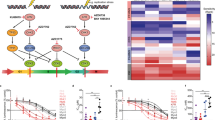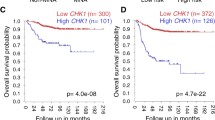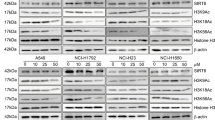Abstract
A number of drugs developed against cancer-specific molecular targets have been shown to offer survival benefits alone or in combination with standard treatments, especially for those cases in which tumor pathogenesis is dominated by a single molecular abnormality. One example for such a tumor type is alveolar rhabdomyosarcoma (aRMS), which is characterized by a specific translocation creating the oncogenic PAX3/FKHR transcription factor, believed to be the molecular basis of the disease. Recently, we were able to show that the small molecule inhibitor PKC412 (midostaurin) shows strong antitumor activity against aRMS by reducing the transcriptional activity of PAX3/FKHR. In this study, we screened for combination strategies that are superior to PKC412-only treatment and found that the combination of PKC412 with histone deacetylase inhibitors like valproic acid (VPA) synergistically induced apoptosis resulting in suppressed aRMS tumor growth in vivo. We provide evidence that the antitumor effect on combination treatment is achieved by VPA-induced reactivation of p21, which is downregulated in aRMS cells by destabilization of the transcriptional regulator EGR1 by PAX3/FKHR. Our study highlights a possible mechanism behind the increased efficacy and indicates that different arms of PAX3/FKHR oncogenicity can be exploited therapeutically by the specific combination of drugs to increase their therapeutic potential.
This is a preview of subscription content, access via your institution
Access options
Subscribe to this journal
Receive 50 print issues and online access
$259.00 per year
only $5.18 per issue
Buy this article
- Purchase on Springer Link
- Instant access to full article PDF
Prices may be subject to local taxes which are calculated during checkout






Similar content being viewed by others
References
Amstutz R, Wachtel M, Troxler H, Kleinert P, Ebauer M, Haneke T et al. (2008). Phosphorylation regulates transcriptional activity of PAX3/FKHR and reveals novel therapeutic possibilities. Cancer Res 68: 3767–3776.
Archer SY, Meng S, Shei A, Hodin RA . (1998). p21(WAF1) is required for butyrate-mediated growth inhibition of human colon cancer cells. Proc Natl Acad Sci USA 95: 6791–6796.
Bali P, George P, Cohen P, Tao J, Guo F, Sigua C et al. (2004). Superior activity of the combination of histone deacetylase inhibitor LAQ824 and the FLT-3 kinase inhibitor PKC412 against human acute myelogenous leukemia cells with mutant FLT-3. Clin Cancer Res 10: 4991–4997.
Barlow JW, Wiley JC, Mous M, Narendran A, Gee MF, Goldberg M et al. (2006). Differentiation of rhabdomyosarcoma cell lines using retinoic acid. Pediatr Blood Cancer 47: 773–784.
Bernasconi M, Remppis A, Fredericks WJ, Rauscher III FJ, Schafer BW . (1996). Induction of apoptosis in rhabdomyosarcoma cells through down-regulation of PAX proteins. Proc Natl Acad Sci USA 93: 13164–13169.
Breneman JC, Lyden E, Pappo AS, Link MP, Anderson JR, Parham DM et al. (2003). Prognostic factors and clinical outcomes in children and adolescents with metastatic rhabdomyosarcoma—a report from the Intergroup Rhabdomyosarcoma Study IV. J Clin Oncol 21: 78–84.
Cao L, Yu Y, Darko I, Currier D, Mayeenuddin LH, Wan X et al. (2008). Addiction to elevated insulin-like growth factor I receptor and initial modulation of the AKT pathway define the responsiveness of rhabdomyosarcoma to the targeting antibody. Cancer Res 68: 8039–8048.
Choi BH, Kim CG, Bae YS, Lim Y, Lee YH, Shin SY . (2008). p21 Waf1/Cip1 expression by curcumin in U-87MG human glioma cells: role of early growth response-1 expression. Cancer Res 68: 1369–1377.
Ebauer M, Wachtel M, Niggli FK, Schafer BW . (2007). Comparative expression profiling identifies an in vivo target gene signature with TFAP2B as a mediator of the survival function of PAX3/FKHR. Oncogene 26: 7267–7281.
Furukawa Y, Vu HA, Akutsu M, Odgerel T, Izumi T, Tsunoda S et al. (2007). Divergent cytotoxic effects of PKC412 in combination with conventional antileukemic agents in FLT3 mutation-positive versus -negative leukemia cell lines. Leukemia 21: 1005–1014.
Gartel AL, Radhakrishnan SK . (2005). Lost in transcription: p21 repression, mechanisms, and consequences. Cancer Res 65: 3980–3985.
Genini M, Schwalbe P, Scholl FA, Schafer BW . (1996). Isolation of genes differentially expressed in human primary myoblasts and embryonal rhabdomyosarcoma. Int J Cancer 66: 571–577.
Kikuchi K, Tsuchiya K, Otabe O, Gotoh T, Tamura S, Katsumi Y et al. (2008). Effects of PAX3-FKHR on malignant phenotypes in alveolar rhabdomyosarcoma. Biochem Biophys Res Commun 365: 568–574.
Kim DH, Rossi JJ . (2007). Strategies for silencing human disease using RNA interference. Nat Rev Genet 8: 173–184.
Kim JS, Lee S, Lee T, Lee YW, Trepel JB . (2001). Transcriptional activation of p21(WAF1/CIP1) by apicidin, a novel histone deacetylase inhibitor. Biochem Biophys Res Commun 281: 866–871.
Kolb EA, Gorlick R, Houghton PJ, Morton CL, Lock R, Carol H et al. (2008). Initial testing (stage 1) of a monoclonal antibody (SCH 717454) against the IGF-1 receptor by the pediatric preclinical testing program. Pediatr Blood Cancer 50: 1190–1197.
Liu C, Adamson E, Mercola D . (1996). Transcription factor EGR-1 suppresses the growth and transformation of human HT-1080 fibrosarcoma cells by induction of transforming growth factor beta 1. Proc Natl Acad Sci USA 93: 11831–11836.
Merlino G, Helman LJ . (1999). Rhabdomyosarcoma—working out the pathways. Oncogene 18: 5340–5348.
Meyer WH, Spunt SL . (2004). Soft tissue sarcomas of childhood. Cancer Treat Rev 30: 269–280.
Mottet D, Pirotte S, Lamour V, Hagedorn M, Javerzat S, Bikfalvi A et al. (2009). HDAC4 represses p21(WAF1/Cip1) expression in human cancer cells through a Sp1-dependent, p53-independent mechanism. Oncogene 28: 243–256.
Pappo AS, Anderson JR, Crist WM, Wharam MD, Breitfeld PP, Hawkins D et al. (1999). Survival after relapse in children and adolescents with rhabdomyosarcoma: a report from the Intergroup Rhabdomyosarcoma Study Group. J Clin Oncol 17: 3487–3493.
Ragione FD, Cucciolla V, Criniti V, Indaco S, Borriello A, Zappia V . (2003). p21Cip1 gene expression is modulated by Egr1: a novel regulatory mechanism involved in the resveratrol antiproliferative effect. J Biol Chem 278: 23360–23368.
Raney RB, Anderson JR, Barr FG, Donaldson SS, Pappo AS, Qualman SJ et al. (2001). Rhabdomyosarcoma and undifferentiated sarcoma in the first two decades of life: a selective review of intergroup rhabdomyosarcoma study group experience and rationale for Intergroup Rhabdomyosarcoma Study V. J Pediatr Hematol Oncol 23: 215–220.
Roeb W, Boyer A, Cavenee WK, Arden KC . (2007). PAX3-FOXO1 controls expression of the p57Kip2 cell-cycle regulator through degradation of EGR1. Proc Natl Acad Sci USA 104: 18085–18090.
Roeb W, Boyer A, Cavenee WK, Arden KC . (2008). Guilt by association: PAX3-FOXO1 regulates gene expression through selective destabilization of the EGR1 transcription factor. Cell Cycle 7: 837–841.
Smith LM, Anderson JR, Qualman SJ, Crist WM, Paidas CN, Teot LA et al. (2001). Which patients with microscopic disease and rhabdomyosarcoma experience relapse after therapy? A report from the soft tissue sarcoma committee of the children's oncology group. J Clin Oncol 19: 4058–4064.
Sowa Y, Orita T, Minamikawa S, Nakano K, Mizuno T, Nomura H et al. (1997). Histone deacetylase inhibitor activates the WAF1/Cip1 gene promoter through the Sp1 sites. Biochem Biophys Res Commun 241: 142–150.
Wilson AJ, Byun DS, Popova N, Murray LB, L'Italien K, Sowa Y et al. (2006). Histone deacetylase 3 (HDAC3) and other class I HDACs regulate colon cell maturation and p21 expression and are deregulated in human colon cancer. J Biol Chem 281: 13548–13558.
Acknowledgements
We thank professor Soon Young Shin for providing constructs encoding EGR1 and p21 luciferase reporter plasmid, Silvia Behnke for her help with the stainings of tumor sections and Sarah Steinbacher for her graphical support in designing Figure 6. This work was supported by grants (3100–109837 and 3100–122562) from the Swiss National Science Foundation (SNF).
Author information
Authors and Affiliations
Corresponding author
Ethics declarations
Competing interests
The authors declare no conflict of interest.
Additional information
Supplementary Information accompanies the paper on the Oncogene website
Rights and permissions
About this article
Cite this article
Hecker, R., Amstutz, R., Wachtel, M. et al. p21 Downregulation is an important component of PAX3/FKHR oncogenicity and its reactivation by HDAC inhibitors enhances combination treatment. Oncogene 29, 3942–3952 (2010). https://doi.org/10.1038/onc.2010.145
Received:
Revised:
Accepted:
Published:
Issue Date:
DOI: https://doi.org/10.1038/onc.2010.145
Keywords
This article is cited by
-
Targeting the undruggable: exploiting neomorphic features of fusion oncoproteins in childhood sarcomas for innovative therapies
Cancer and Metastasis Reviews (2019)
-
Concomitant epigenetic targeting of LSD1 and HDAC synergistically induces mitochondrial apoptosis in rhabdomyosarcoma cells
Cell Death & Disease (2017)
-
Exosomes derived from embryonal and alveolar rhabdomyosarcoma carry differential miRNA cargo and promote invasion of recipient fibroblasts
Scientific Reports (2016)
-
Valproic acid sensitizes pancreatic cancer cells to natural killer cell-mediated lysis by upregulating MICA and MICB via the PI3K/Akt signaling pathway
BMC Cancer (2014)
-
Loss of MEF2D expression inhibits differentiation and contributes to oncogenesis in rhabdomyosarcoma cells
Molecular Cancer (2013)



